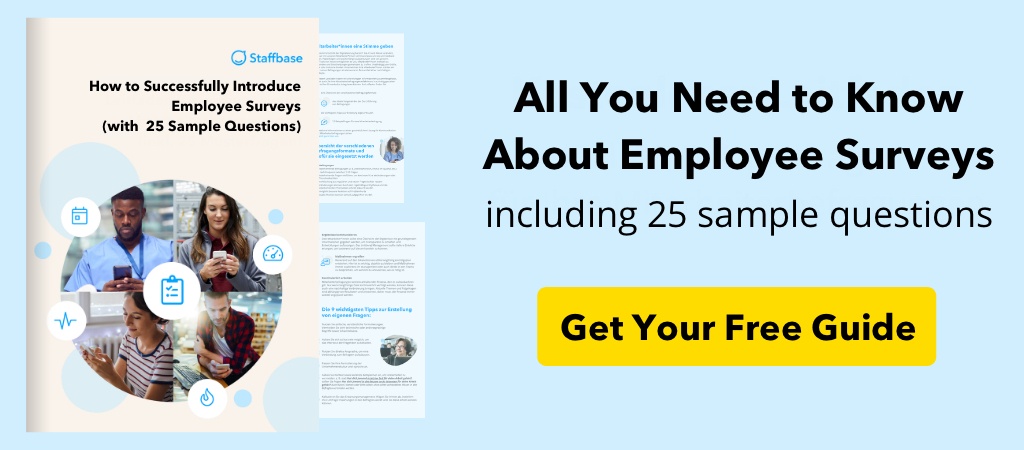It’s time to put down the megaphone and start a real conversation.
But with a large workforce, segmented into various departments, spread across remote set-ups and offices (and maybe even continents), having a real conversation with employees seems pretty much impossible.
One of the most common frustrations that we hear from internal communicators is that they don’t believe their comms strategy generates a real exchange of ideas.
It’s not easy to strike a balance between the megaphone management styles so often used by disconnected leadership and the kind of honest communication and connection that’s crucial for engaging employees and cultivating a healthy company culture.
And the biggest obstacle to achieving this balance? It’s a lack of employee feedback.
Without feedback, your internal communications can seem like a one-way street. If we are really dedicated to this idea of starting a real conversation with our internal comms, what are we to do?

How the right pulse survey questions can get employees engaging with your content
Don’t worry, if you are already using Staffbase or another platform that provides engagement metrics, you’re already halfway to a great conversational content strategy. (And if you’re not, isn’t it time to see what we’re all about?)
We’ve posted quite a bit about how to measure your key internal comms metrics — which is really important. But this is just the first step in measuring your impact.
If you want to create a content strategy that gets employees co-creating and engaging with your content, you need to take your measurement game to the next level.
Download our Quickstart Guide to Pulse Surveys here.
Tracking email opens is just the first step to a great internal content strategy
Knowing when, where, and how an employee opened your email is extremely valuable information. Data on what time of day people are opening, which day of the week gets the most opens, and how many times employees revisit an email are all great starting points to develop a data-backed strategy.
The problem is, even if employees are opening your emails, it doesn’t necessarily mean that your strategy is working.
Getting employees to open the email is the first hurdle, but finding out if they read it, liked it, understood it, or found it useful isn’t easy to gauge just from aggregate data on email opens.
What’s in a click?
Tracking link clicks is the next step. If employees are opening your emails and clicking the links, you can at least assume that they’re reading or at least scanning through them.
And that’s a win.
But if they start clicking on links that they don’t find relevant, valuable, or enjoyable, you’ll alienate your reader. You’ll be stuck trying to work extra hard to re-engage these readers and grab their attention.
At least if they aren’t clicking, you can pretty much guarantee they aren’t interested, don’t find the information relevant, or aren’t actually reading the emails. But hey, it can only get better from here!
Your secret weapon for employee engagement: The pulse survey
What if you had a way for employees to tell you — anonymously — whether they found your content useful or engaging?
What if you had a way to engage or re-engage an alienated audience by giving them an easy way to provide valuable feedback with just a click?
Well, all of this is possible with an embedded employee pulse survey.
With a pulse survey, all it takes is a click for an employee to express how the content impacted them.
In return, you get valuable data on your messaging. You can figure out if it’s actually working, if you need to double-down, or if it’s time to pivot your strategy. It gives you the opportunity to test new angles or try creative messaging, without worrying about being unsure whether or not it landed.
If you have employees using pulse surveys to provide feedback, even a failed strategy is salvageable.
At the very least, having the option to provide feedback will keep employees opening the emails, clicking, and engaging. Employees will begin to anticipate a change in the content based on their pulse survey feedback, which is likely to keep them engaged in the conversation.
This is what engaging employees in an authentic conversation looks like. By using pulse surveys, you can actively model and facilitate a culture of open communication that is responsive and considerate of employees needs, desires, and time.
How to use different pulse survey styles to discover the content your employees want to read
When it comes to choosing which style of pulse survey you use, you've got lots of options (especially if you’re using Staffbase already.) We've found that the best pulse survey styles for diagnosing your content and collecting feedback from employees are dichotomous surveys (surveys with a scale of two opposite choices, like “Yes” or “No”), comments, social reactions, and likes.
Each of these pulse survey styles has its time and place and gives you a different way to collect employee feedback. But when it comes to learning how to interpret the data gathered from pulse survey questions, dichotomous pulse surveys are an easy place to start. Because they are so straightforward, ask a specific question, and limit the response options, the answers are easier to interpret so you can take action right away.
Without further ado, we present to you the three dichotomous pulse survey questions that you need to be asking to get actionable employee feedback on your content.
1. Is this helpful?
Knowing whether employees found your content helpful or not is a great way to gauge the kind of content they want to see.
This survey is engaging because it allows employees to communicate how they want to interact with content and what their needs are. This information will allow you to pivot your content strategy to provide better, more helpful content.
Having an opportunity to be heard and influence what kind of content you include in your emails will also encourage engagement. Employees may be more likely to keep clicking and provide feedback in the future if they know you’re listening.

Why it’s great:
- Easy to fill out
- Will tell you how helpful employees found the content
- Can help you anticipate the needs of your employees based on their feedback
- Can help you pivot and focus your strategy for higher engagement
When to use it:
- Sharing industry-based information
- Communicating about company news that affects employees
- Educating or providing resources to your employees
When not to use it:
- To find out if employees understand policy, organizational, or leadership changes
- When you want to know if employees liked a particular piece of content
- To gauge sentiment on "fluff" content, like whether or not they enjoyed the Halloween party
2. Do you understand this?
Knowing whether employees understand a policy change, an organizational change, or a new initiative is pretty important — and most of the responsibility for communicating and gauging this falls almost exclusively on internal comms departments.
When you have to send out these kinds of emails, often fraught with corporate jargon, you don’t usually have much room for creativity. Naturally, your focus isn’t so much on whether employees liked it or found it interesting, but whether they understood it — which is a crucial part of the feedback mechanism. After all, if they don't understand the email, it’s unlikely they’ll like it or find it useful.

Why it’s great:
- Easy to fill out
- Gives you an accurate gauge on how many respondents understood the message
- Can help you clarify your language and develop clearer messaging
- Can give you quick insight and the ability to take action based on feedback
When to use it:
- Communicating about organizational or leadership changes
- Announcing new policy or policy changes
- Introducing new initiatives
- Spreading important company-wide news
- When communicating something imperative for employees to understand
When not to use it:
- To find out if employees approve of company changes
- To satisfy compliance rules
- If you want employees to agree or consent to a policy change
- If you are attempting to gauge sentiment around a particular issue
3. Do you like this?
Giving people the ability to express whether or not they like the kind of content you’re sending is a fantastic way to hone your strategy. Employees will feel heard, and in return, you can learn a lot about them as people and employees.
The “I like this / Do not like this” pulse survey can also enable you to take swift, data-based action.
For example, let’s say you announce a new culture initiative and an overwhelming majority of employees say they don’t like it. You now have the statistical significance you need to take this to leadership so they can reevaluate the initiative before it starts creating problems.
Here’s another example: If employees are liking a lot of the content you post about office wellness, this response data is a great way to help leaders make decisions about what kind of office culture changes and initiatives they should focus on. And, of course, you can refocus your content on things in which employees are actually interested.

Why it’s great:
- Easy to fill out
- Can gauge if employees actually like your content
- Can help you pivot and focus your strategy on content that employees like
- Can help you learn about your employees’ likes/dislikes and use that to influence culture
- Can be used to take data-based action
When to use it:
- Providing industry-based information
- Communicating about company news that affects employees
- Educating or providing resources to your employees
- To test fun content or new messaging styles
- When using new engagement strategies
When not to use it:
- To find out if employees understand policy, organizational, or leadership changes
- To see what sort of content is helpful to employees
- To get compliance or consent from employees about policy changes or initiatives
Using pulse survey data to pivot your IC content strategy
Whatever you choose to do with pulse surveys, please don’t ignore the data. That’s a sure way to alienate your readership. If they expect that you’re aware of their concerns yet still not shifting your strategy to respond, they’ll assume their feedback is falling on deaf ears.
Talk about an engagement buzz-kill.
Once you start implementing employee pulse surveys, you’re bound to find interesting takeaways in the data. And of course, you need to react.
After all, if cultivating a culture of communication is what we want, we need to actively participate in the conversation — and that means being a good listener.

Read more about employee surveys:
- Employee Surveys: Guidelines, Tips, and Examples
- The Best Way to Get Employees Onboard with Pulse Surveys [Free Template]
- Why Pulse Surveys Are An Internal Communicator’s Best Friend
- How to Plan Your First Employee Pulse Survey (And Get Results!)
- How Often Should You Send Employee Pulse Surveys?
- Increase Your Employee Survey Responses to 70% With This Tool




